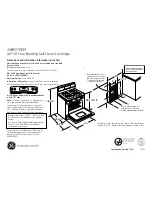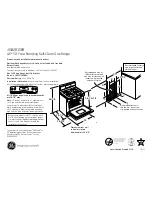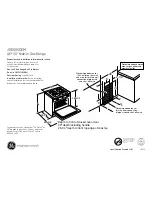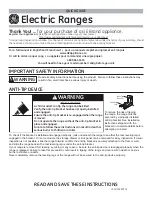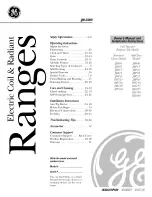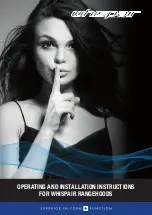
www.insigniaproducts.com
5
NS-RNG24SS9
9
A WARNING: SERIOUS HAZARDS ARE ASSOCIATED WITH REACHING INTO STORAGE
CABINETS ABOVE THE RANGE WHEN THE TOP BURNERS AND/OR OVEN ARE IN OPERATION.
Do not store items that are attractive to children above the range. Do not let clothing come into contact with top
burners when range is in operation.
10
POSSIBLE HAZARDS OR INJURIES MAY RESULT FROM THE MISUSE OF APPLIANCE DOORS OR
DRAWERS
such as stepping, leaning or sitting on the doors or drawers.
11
DO NOT USE THE TOP OF THE RANGE OR THE OVEN AS A STORAGE AREA.
Items stored on the range top can become too hot and melt. Do not store flammable materials in the oven.
12
USE A GOOD POTHOLDER WHEN PULLING OUT OVEN RACKS TO ADD OR REMOVE FOOD.
Dish towels or other substitutes can cause bad burns. Use only dry potholders. Damp or moist potholders on hot
surfaces may result in burns from steam. Do not let a potholder touch a flame.
13
KEEP ALL PLASTICS AWAY FROM THE RANGE,
as plastics are vulnerable to heat.
14
AVOID UNSTABLE, EASILY TIPPED PANS.
Pan handles should be turned to the back or side of the range—
not out into the room or over adjacent burners. Only use utensils that are suitable for range and oven use.
15
DO NOT HEAT UNOPENED CONTAINERS OF FOOD ON SURFACE BURNERS OR IN THE OVEN.
Buildup of pressure may cause the container to burst and result in serious personal harm and/or damage to the range.
16
ALUMINUM FOIL WHEN USED IMPROPERLY IS A CAUSE OF MANY RANGE PROBLEMS.
See the oven and broiler sections of this book for instructions for proper use
17
GREASE IS FLAMMABLE AND SHOULD BE HANDLED CAREFULLY.
Avoid letting grease deposits collect
around the range or in vent fans. Let quantities of hot fat, a pan of deep fat for example, cool before attempting to
move it. If a grease fire should occur in a pan, put out the flame by placing a lid on the pan. DO NOT throw water on a
grease fire. Do not turn on the vent hood. Use a dry chemical or foam type fire extinguisher. If a fire should occur in the
oven or broiler, tum off the oven, close the oven door and broiler door and allow the food or grease to burn itself out in
the oven. If smoke or fire persist, call your local fire department.
18
AVOID THE USE OF AEROSOL SPRAYS NEAR A RANGE AS MOST ARE FLAMMABLE.
19
NEVER LEAVE SURFACE BURNERS UNATTENDED AT HIGH OR MEDIUM FLAME SETTINGS.
Adjust top burner flame size so it does not extend beyond the edge of the cookware. Excessive flame is hazardous
20
DO NOT USE A RANGE THAT IS IN NEED OF REPAIR.
Repairs should be done by a qualified person. Poorly
done repairs could result in a safety hazard. Do not replace or repair any part of the range yourself unless it is
recommended in this book.
21
DO NOT TOUCH THE INTERIOR SURFACES OF THE OVEN DURING OR IMMEDIATELY AFTER
USE.
Do not let clothing or other flammable materials contact burners. Although these surfaces may be dark in color
they can still be hot enough to burn. Other areas of the range can become hot enough to cause burns, such as vent
openings, main top, window, oven door, broiler door and oven racks.
22
DO NOT OBSTRUCT THE FLOW OF COMBUSTION OR VENTILATION AIR.
23
BE SURE ALL PACKING MATERIALS ARE REMOVED FROM THE RANGE
before operating it to prevent
fire or smoke damage should the packing material ignite.
24
LEAK TESTING OF THE APPLIANCE SHALL BE CONDUCTED ACCORDING TO THE
MANUFACTURER'S INSTRUCTIONS.
Installation instructions
• The installation must conform with local codes or, in the absence of local codes, with the national Fuel Gas Code, ANSI
Z223.1/NFPA 54 or, in Canada the Propane Gas Installation Code, CSA B149.1.
• The installation of appliances designed for manufactured (mobile) home installation must conform with the
Manufactured Home Construction and Safety Standard, Title 24 CFR, Part 3280 (formerly the Federal Standard for
Mobile Home Construction and Safety, Title 24, HUD (part 280)).
• The installation of appliances designed for recreational park trailers must conform with state codes, with the standard
for Recreational Park Trailers, ANSI A119.5.
• When installed, the range must be electrically grounded in accordance with local codes.
• The range and its individual shut-off valve must be disconnected from the gas supply piping system during any
pressure testing of that system at test pressures in excess of 1/2 psi (3.5 k Pa).
• The range must be isolated from the gas supply piping system by closing its individual manual shut-off valve during
any pressure testing of the gas supply piping system at test pressures equal to or less than 1/2 psi (3.5 k Pa).
• The maximum gas supply pressure must be in accordance with the manifold 10" WC inlet pressure rating of the gas
appliance pressure regulator supplied.
• The gas supply pressure for checking the regulator setting must be at least 1" WC (249 Pa) above the manufacturer's
specified manifold pressure. Any opening in the wall behind the range and in the floor under the range must be sealed.
SAVE THESE INSTRUCTIONS





















